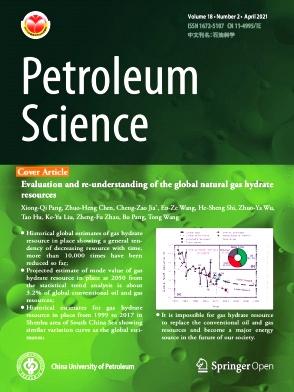Insights into the pore structure and hydrocarbon accumulation of lacustrine organic-rich shales
IF 6
1区 工程技术
Q2 ENERGY & FUELS
引用次数: 0
Abstract
With the development of unconventional hydrocarbon, how to improve the shale oil and gas recovery become urgent. Therefore hydraulic fracturing becomes the key due to the complicated properties of the reservoirs. The pore structure not only plays an essential role in the formation of complex fracture networks after fracturing but also in resource accumulation mechanism analyses. The lacustrine organic-rich shale samples were selected to carry out petrophysical experiments. Scanning Electron Microscopy (SEM) and X-ray Diffraction were performed to elucidate the geology characteristics. MICP, 2D NMR, CT, and N2 adsorption were conducted to classify the pore structure types. The contribution of pore structure to oil accumulation and hydrocarbon enrichment was explained through the N2 adsorption test on the original and extracted state and 2D NMR. The results show that micropores with diameter less than 20 nm are well-developed. The pore structure was divided into three types. Type I is characterized by high porosity, lower surface area, and good pore throat connectivity, with free oil existing in large pores, especially lamellation fractures. The dominant nano-pores are spongy organic pores and resources hosted in large pores have been expelled during high thermal evolution. The content of nano-pores (micropores) increases and the pore volume decreases in Type II pore structure. In addition, more absorbed oil was enriched. The pore size distribution of type II is similar to that of type I. However, the maturity and hydrocarbon accumulation is quite different. The oil reserved in large pores was not expelled attributed to the relatively low thermal evolution compared with type I. Structural vitrinite was observed through SEM indicating kerogen of type III developed in this kind of reservoir while the type of kerogen in pore structure I is type II. Type III pore structure is characterized by the largest surface area, lowest porosity, and almost isolated pores with rarely free oil. Type I makes the most contribution to hydrocarbon accumulation and immigration, which shows the best prospect. Of all of these experiments, N2 adsorption exhibits the best in characterizing pores in shales due to its high resolution for the assessment of nano-scale pores. MICP and NMR have a better advantage in characterizing pore space of sandstone reservoirs, even tight sandstone reservoirs. 2D NMR plays an essential role in fluid recognition and saturation calculation. CT scanning provides a 3D visualization of reservoir space and directly shows the relationship between pores and throats and the characteristics of fractures. This study hopes to guide experiment selection in pore structure characterization in different reservoirs. This research provides insight into hydrocarbon accumulation of shales and guidance in the exploration and development of unconventional resources, for example for geothermal and CCUS reservoirs.
求助全文
约1分钟内获得全文
求助全文
来源期刊

Petroleum Science
地学-地球化学与地球物理
CiteScore
7.70
自引率
16.10%
发文量
311
审稿时长
63 days
期刊介绍:
Petroleum Science is the only English journal in China on petroleum science and technology that is intended for professionals engaged in petroleum science research and technical applications all over the world, as well as the managerial personnel of oil companies. It covers petroleum geology, petroleum geophysics, petroleum engineering, petrochemistry & chemical engineering, petroleum mechanics, and economic management. It aims to introduce the latest results in oil industry research in China, promote cooperation in petroleum science research between China and the rest of the world, and build a bridge for scientific communication between China and the world.
 求助内容:
求助内容: 应助结果提醒方式:
应助结果提醒方式:


